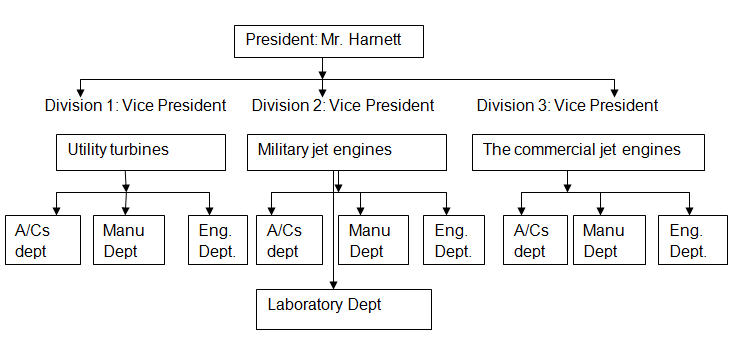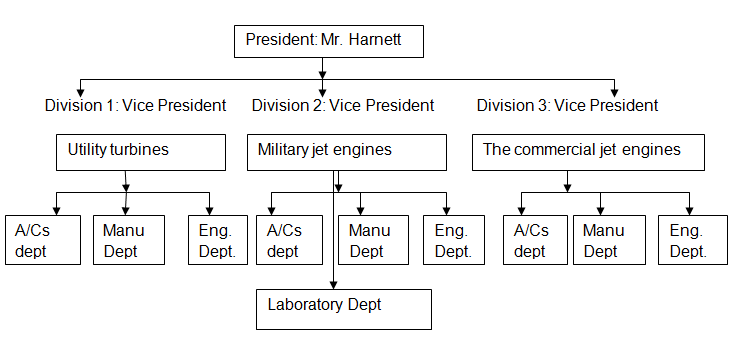Case Study Background
An extensive reorganization became noticeable at Tucker Corporation in the fiscal year 1993. This made the Corporation to be divided into three key product segments namely utility turbines, military engines and the commercial jet engines.
Each segment was to be governed by a vice president directly reporting to Mr. Harnett, the corporation president. For independent operations, each segment had its own accounting, manufacturing, engineering and other departments.
The segments often found it indispensable to use other departments or segment services in order to avoid incurring additional facilities and staffing costs. For instance, laboratory happened to be a commonly shared department.
The laboratory manager had to report directly to the military jet engines segment manager (Samson & Daft, 2011). Thus, from the organizational chart underneath, it is apparent that the laboratory subdivision had to be situated in the segment of military jet engines for the reason that the administrator had to be openly answerable to the military jets engines director.
Tucker Corporation Divisional organizational structure

Conflicts between Mr. Franklin and Miss Hodge
Modest interdepartmental conflicts became well known before the retirement of the laboratory manager, Mr. Garfield in the fiscal 1999. Nonetheless, subsequent to assuming Mister Garfield position, Miss Hodge impatiently sought to attain the interest of Tucker Corporation’s administration.
She barely spearheaded Tucker Corporation interests but almost exclusively advanced private affairs. In not more than half a year Miss Hodge had been an employee of Tucker Corporation; there was a range of inter-departmental clashes.
The production unit for instance, was formerly utilizing the lab department to investigate the preferred resources constituents. Miss Hodge however had the sensation that the lab ought to integrate assorted actions that is; choosing supplies, assessing tentative statistics and crafting experimentation.
Despite offering to have consultation with Miss Hodge, Mr. Franklin affirmed that his department will make the ultimate selection decision. This disagreement allowed other results implementation conflicts to arise. Franklin averred that the spot held by Hodge in the testing lab made her inept to understand the wide-ranging plan reflections disturbing the eventual material assortment judgments.
On the other hand, she assumed that, like most metallurgists, she had resources knowledge which Mister Franklin was short of. Thus, when compared to Mister Garfield’s administration, Mister Franklin realized that any demand he made underneath the administration of Miss Hodge had to take somewhat longer time.
She recognized that troubles correlated to services jet engines had to be given foremost precedence due to the configuration of the admin. Additionally, she declared that she would value Mister Franklin’s dilemma and need by reworking technical precedence. When a significant assignment deemed necessary by Franklin did not get critical scheduling, pressure mounted between Franklin and Hodge.
A change in the schedule was therefore requested by Mr. Franklin who also showed dissatisfaction with the low level of precedence his department received. When Miss Hodge heard about this, she mentioned that Mr. Franklin did not welcome the idea of meeting and resolving the ensuing problems.
From the above conflict analysis, it is true that conflicts were based on personalities other than the manner in which the organisation was planned.
Subsequent crisis
Principally, from Tucker firm case, it materializes that apprehension and disagreement occurred amid the lab administrator and engineering subdivision director.
Analysis of each alternative solution
The new organizational structure

From the above newly designed organizational structure, the following solutions were apparent and they offer the associated advantages and disadvantages.
Solution a: Employee groups from different functional subdivisions should convene to unravel the emerging common problems.
This solution is equally dubbed as cross functional team solution. The solution requires employees who are responsible to come from different departments that are perceived to be functional to assemble as one team to solve the emanating problems.
A member of such a team may be elected as a leader. There is the provision for horizontal coordination in cross functional team which helps in complementing the existing sub-divisional arrangement (Samson & Daft, 2011).
If Tucker uses this solution, various departmental workers might be obtained from every segment to assemble like a team to solve the ensuing problems.
The selected employees form a panel charged with the responsibility of discussing workplace encountered problems, departmental scheduling problems as well as other arising issues. The structural scheme will permit Tucker to benefit from exhaustive preparation, economy of scale as well as achieve group attachment reimbursement.
In fact, Tucker’s team concept may aid in breaking down departmental barriers. Each departmental problem will be made apparent and will be compromised instead of pursuing special interests.
The disadvantage of this solution is related to twofold devotions. Cross functional teams impose divergent strain on their affiliates when compared to their departmental managers.
This is because such members are obliged to partake in excess of a single team in matters pertaining to conflict resolution. Cross functional teams implementation also causes much devolution whereby senior managers in the departments have feelings of being left out in departmental teams decisions.
Solution b: Tucker Company management may leave everything as it is and do nothing about it.
This solution ideally leaves Miss Hodge and Mr. Franklin in the prevailing state. Numerous troubles are periodically anticipated. Thus, it will be difficult to get the assigned tasks completed as a result of the accruing disagreements.
Every job aspect will be significantly affected, the spirits of employees will deteriorate, output will decrease, and Tucker’s efficiency and profitability may decline if the management does nothing to offer conflict solutions (Daft & Marcic, 2005).
Solution c: The management can reorganize Tucker Corporation in manner that all divisions receive equal service provisions from the laboratory.
This can be realized through restructuring Tucker in order for the divisionally shared laboratory to offer equivalent services to each of the recognized units. This would help Franklin to avoid complaining to Hodge that dismal precedence was given to his department in matters pertaining to lab services. Equal treatment will ensure inter-departmental conflicts are reduced.
However, the solution is disadvantageous because additional costs will be incurred in terms of facilities purchase and additional staffing. Proviso projects have no priorities attachments, both urgent projects and less essential projects might end up being completed at identical periods.
Solution d: Mr. Harnett should call for a meeting and head the meeting amid Mr. Franklin and Miss Hodge to help discuss their future concerns, resolve their differences as well as problems.
Given that Mr. Harnett is Tucker’s president, he is obliged to resolve this preventable conflict by acting as a mediator. The two should sit down before the president, discuss all the issues at hand and air out their concerns.
Matters relating to untimely service delivery in the lab which were not experienced in the past should be mentioned and solved while reasonable scheduling must be adhered to. Mr. Franklin ought o be prepared to listen to any order discrepancy issues from Miss Hodge.
Since individuals have conflicting personality differences, these must be left out in all workplaces including offices (Higgins & Striegel, 2003).
The best alternative solution
From the above named solutions, it is reasonably clear that solution “d” is the most viable solution.
Justifying the best alternative solution related to the conflict
Basically, when the management opts to restructure Tucker Corporation, the idea might be considered costly and a major one. This appears to be hardly crucial since Tucker initially operated both effectively and efficiently under a similar type of organizational and managerial structure.
Conversely, leaving the company in its current state might not be a viable solution since the apparent problems would remain unsolved. This might imply a downfall. When a cross functional team is built, it would require incorporating even the non-partisan or everyone who is not involved to solve a problem that only requires the commitment of Mr. Franklin and Miss Hodge.
Problems only mounted after Mr. Garfield had left the office. Primarily, hardly any disagreements were reported and the conclusions of ventures were punctual. Therefore, it may be alleged that Miss Hodge, the present laboratory manager is incapable of managing lab issues.
However, it is rarely difficult for the incumbents to quickly adjust to new situations and thus, Tucker Corporations employees should allow Miss Hodge to slowly adjust to the way they expect her to handle laboratory issues.
This can be realized through allowing Mr. Harnett to call for a meeting and head the meeting between Mr. Franklin and Miss Hodge to help discus their future concerns, resolve their differences as well as the encountered problems.
References
Daft, R. L. & Marcic, D. (2005). Understanding management. Florence, KY: Cengage Learning.
Higgins, S. & Striegel, C. (2003). Movies for business: Big-screen lessons in corporate visions, entrepreneurship, logistics and ethics. Spokane, WA: New Media Ventures, Inc.
Samson, D & Daft, R. L. (2011). Management: Asia Pacific Edition. Florence, KY: Cengage Learning.